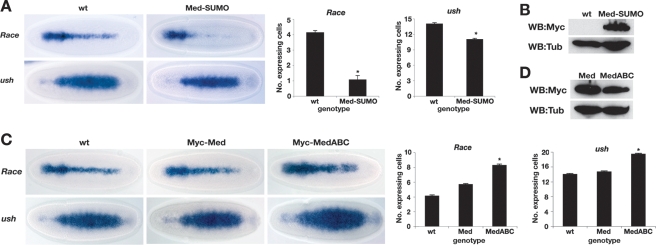Figure 4.
Failure to SUMOylate Med increases Dpp signaling range. (A) Tethering SUMO to Med represses Dpp target genes. Dorsal views of gastrulating embryos showing Race and ush staining. Embryos are either wild type or express a Med-SUMO fusion protein. Graphs show quantification of the number of Race or ush expressing cells in the middle of the embryo; n = 15; error bars are SEM; (*) P < 0.05 (Student’s t-test). (B) Western blot analysis of 2- to 4-h extracts from the embryos shown in A confirms expression of the Myc epitope-tagged Med-SUMO fusion protein. The Tubulin signal serves as a loading control. (C) Med that cannot be SUMOylated has higher transcriptional activity. RNA in situ hybridization of gastrulating wild-type embryos and those overexpressing wild-type or mutant Med proteins, with Race and ush probes. Embryos are oriented with dorsal up. Graphs and quantification are as in A. (D) As in B except that extracts from embryos overexpressing wild-type or mutant Med are analyzed.

